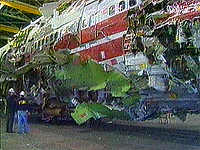TWA 800 Recommendations Focus On Improving Wiring Safety
By Sean Broderick
23-Aug-2000 6:25 PM U.S. EDT

Recommendations approved today by the U.S. National Transportation Safety Board (NTSB) put a strong emphasis on improving the way everyone in commercial aviation - from aircraft designers to mechanics - deals with wiring systems.
Two of the four recommendations, made as part of the TWA 800 investigation final draft report, deal specifically with wiring design, safety, and upkeep. The NTSB called on the U.S. Federal Aviation Administration (FAA) to review aircraft design specifications to determine what wiring systems are safety-critical. Once that's done, standards on how to protect the most critical wire systems should be established and put into place.
The board also wants the FAA to come up with new continued airworthiness guidelines for handling wiring systems, including a way to record in-service wiring problems, new training for mechanics on how to recognize and deal with degrading wiring, and improving inspection procedures by using new technology.
A third recommendation calls on the FAA to review manufacturer design practices on bonding components in fuel tanks with an eye on eliminating ignition sources, while a fourth urges the agency to come up with ways to eliminate silver sulfide build-ups from fuel tank components.
As expected, the board pegged an explosion in the center fuel tank as the cause of the July 17, 1996 crash of the TWA Boeing 747-131 that killed all 230 onboard. Contributing factors cited were the notion that fuel tank explosions could be prevented solely by eliminating ignition sources, and Boeing's design that place air conditioning packs under the 747 center fuel tank without either insulation to prevent heat build-up in the tank or a way to remove oxygen from the tank.
Investigators could not determine "with certainty" what ignited the fuel, but the board believes the "most likely scenario" was a short-circuit originating outside the center tank that was transferred to lower-voltage center wing tank fuel quantity indication system (FQIS) wiring. The FQIS wiring is designed with a voltage level that, by itself, would not pose an ignition threat.
Failing to nail down the ignition source hardly makes the four-year, $35 million probe a failure, however. In fact, several people involved in the investigation say that forcing investigators to examine all potential ignition scenarios is what brought myriad other safety deficiencies, such as the extent of wiring problems, to light.
"If we would have found the ignition source in the third week, think of all the discoveries we might not have made," former NTSB Vice Chairman Robert Francis, who was the top board member at the on-site part of the TWA probe, told AviationNow.com . "The work that's been done over the last four years has been a tremendous benefit to civil aviation safety worldwide, going well beyond fuel tank safety."
Board member John Goglia echoes Francis' theme, calling for the industry "to not let this work go away, to not forget the lessons learned. We must continue with the diligence to make sure every single item investigators have identified is brought to a satisfactory conclusion."
Goglia, a long-time airline mechanic before joining the board, believes the TWA 800 accident probe findings will leave a memorable mark in aviation safety history. "It's the Aloha for non-structural systems," he told AviationNow.com , referring to the 1988 Aloha 737 incident that opened the industry's eyes to the seriousness of aging aircraft structural problems.
The board approved 25 findings as part of the TWA report. Key ones include determining that silver sulfide build-ups commonly found inside tanks pose an ignition risk, designs that put heat-generating equipment directly under fuel tanks without proper insulation or fuel inerting can "unnecessarily increase the amount of time" that aircraft operate with a deadly fuel/air mixture, and "until recently, insufficient attention has been paid to the condition of aircraft electrical wiring," resulting in potential safety hazards.
The board did not pull back any previous recommendations. During testimony, board and staff members stressed the importance of ensuring the FAA follows through with still-unresolved recommendations, including developing fuel inerting systems.
Before this week's board meeting, NTSB had issued 11 recommendations based on information gleaned from the TWA 800 probe. Only one of them remains classified as open/unacceptable: a request to require temperature probes in fuel tanks so pilots can monitor fuel temperatures. FAA says pending programs such as tank ventilation and inerting systems would eliminate the need for the temperature probes, but the board wants to see the programs put into practice before accepting the agency's response to the recommendation.
The two-day meeting ended with the board unanimously approving the probable-cause statement, the findings, and the recommendations. A final report, which will likely change little from the working document that was the centerpiece of discussion this week, will be out later this year.
See Also: